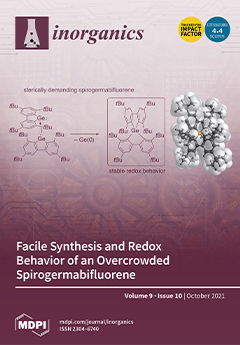Ten mononuclear rare earth complexes of formula [La(btfa)
3(H
2O)
2] (
1), [La(btfa)
3(4,4′-Mt
2bipy)] (
2), [La(btfa)
3(4,4′-Me
2bipy)
2] (
3), [La(btfa)
3(5,5′-Me
2bipy)
2] (
4), [La(btfa)
3(terpy)] (
5), [La(btfa)
3(phen)(EtOH)] (
6), [La(btfa)
3(4,4′-Me
2bipy)(EtOH)] (
7), [La(btfa)
3(2-benzpy)(MeOH)] (
8), [Tb(btfa)
3(4,4′-Me
2bipy)] (
9) and (Hpy)[Eu(btfa)
4] (
10), where btfa = 4,4,4-trifuoro-1-phenylbutane-1,3-dionato anion, 4,4′-Mt
2bipy = 4,4′-dimethoxy-2,2′-bipyridine, 4,4′-Me
2bipy = 4,4′-dimethyl-2,2′-bipyridine, 5,5′-Me
2bipy = 5,5′-dimethyl-2,2′-bipyridine, terpy = 2,2′:6′,2′-terpyridine, phen = 1,10-phenathroline, 2-benzpy = 2-(2-pyridyl)benzimidazole, Hpy = pyridiniumH
+ cation) have been synthesized and structurally characterized. The complexes display coordination numbers (CN) eight for
1,
2,
9,
10, nine for
5,
6,
7,
8 and ten for
3 and
4. The solid-state luminescence spectra of Tb-
9 and Eu-
10 complexes showed the same characteristic bands predicted from the Tb(III) and Eu(III) ions. The Overall Quantum Yield measured (
ϕTOT) at the excitation wavelength of 371 nm for both compounds yielded 1.04% for
9 and up to 34.56% for
10.
Full article





